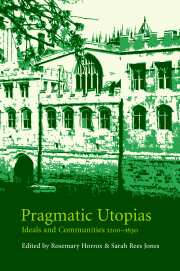Book contents
- Frontmatter
- Contents
- Preface
- List of abbreviations
- Richard Barrie Dobson: an appreciation
- 1 ‘If heaven be on this earth, it is in cloister or in school’: the monastic ideal in later medieval English literature
- 2 The ‘Chariot of Aminadab’ and the Yorkshire priory of Swine
- 3 Godliness and good learning: ideals and imagination in medieval university and college foundations
- 4 Hugh of Balsham, bishop of Ely 1256/7–1286
- 5 A cruel necessity? Christ's and St John's, two Cambridge refoundations
- 6 Coventry's ‘Lollard’ programme of 1492 and the making of Utopia
- 7 Thomas More's Utopia and medieval London
- 8 Social exclusivity or justice for all? Access to justice in fourteenth-century England
- 9 Idealising criminality: Robin Hood in the fifteenth century
- 10 Fat Christian and Old Peter: ideals and compromises among the medieval Waldensians
- 11 Imageless devotion: what kind of an ideal?
- 12 An English anchorite: the making, unmaking and remaking of Christine Carpenter
- 13 Victorian values in fifteenth-century England: the Ewelme almshouse statutes
- 14 Puritanism and the poor
- 15 Realising a utopian dream: the transformation of the clergy in the diocese of York, 1500–1630
- Bibliography of Barrie Dobson's published works
- Index
2 - The ‘Chariot of Aminadab’ and the Yorkshire priory of Swine
Published online by Cambridge University Press: 01 July 2009
- Frontmatter
- Contents
- Preface
- List of abbreviations
- Richard Barrie Dobson: an appreciation
- 1 ‘If heaven be on this earth, it is in cloister or in school’: the monastic ideal in later medieval English literature
- 2 The ‘Chariot of Aminadab’ and the Yorkshire priory of Swine
- 3 Godliness and good learning: ideals and imagination in medieval university and college foundations
- 4 Hugh of Balsham, bishop of Ely 1256/7–1286
- 5 A cruel necessity? Christ's and St John's, two Cambridge refoundations
- 6 Coventry's ‘Lollard’ programme of 1492 and the making of Utopia
- 7 Thomas More's Utopia and medieval London
- 8 Social exclusivity or justice for all? Access to justice in fourteenth-century England
- 9 Idealising criminality: Robin Hood in the fifteenth century
- 10 Fat Christian and Old Peter: ideals and compromises among the medieval Waldensians
- 11 Imageless devotion: what kind of an ideal?
- 12 An English anchorite: the making, unmaking and remaking of Christine Carpenter
- 13 Victorian values in fifteenth-century England: the Ewelme almshouse statutes
- 14 Puritanism and the poor
- 15 Realising a utopian dream: the transformation of the clergy in the diocese of York, 1500–1630
- Bibliography of Barrie Dobson's published works
- Index
Summary
The Gilbertine Order has the distinction of being the only medieval monastic congregation to have its origins in Britain. Moreover, of the many new orders of the twelfth century it was one of the few which brought to the foreground the vocation and needs of women, constructing and evolving over a period of several decades a constitution of which the raison d’être was the provision of a way of life for nuns. The mature Gilbertine arrangement was reached around 1150. To the anchoritic women who were now professed nuns according to the Rule of St Benedict, the lay sisters who were added on the advice of Abbot William of Rievaulx (1132–45) to serve the nuns, and the lay brothers who took charge of external affairs of the house, were now attached Augustinian canons, literate men to minister to the women. Although the details concerned with the organisation of daily life and government were augmented and adapted over the years which followed, the basis of the Gilbertine houses remained this fourfold arrangement, which the author of the life of St Gilbert likened to the biblical ‘Chariot of Aminadab’:
This is the chariot of Aminadab, in other words of a willing people who of their own accord have become poor for Christ. It has two sides, one of men, the other of women; and four wheels, two of men, clerks and laymen, and two of women, educated and unlettered.
- Type
- Chapter
- Information
- Pragmatic UtopiasIdeals and Communities, 1200–1630, pp. 26 - 42Publisher: Cambridge University PressPrint publication year: 2001
- 2
- Cited by



